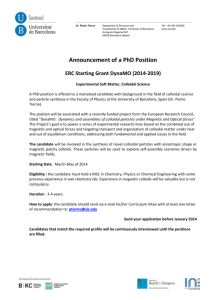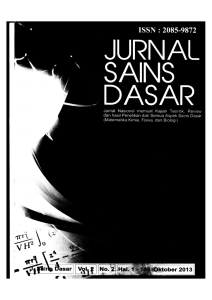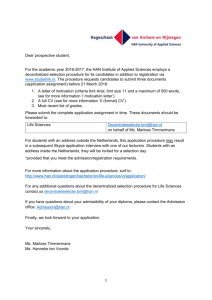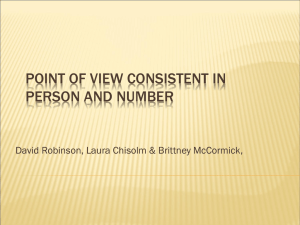as Microsoft Word - Edinburgh Research Explorer
advertisement
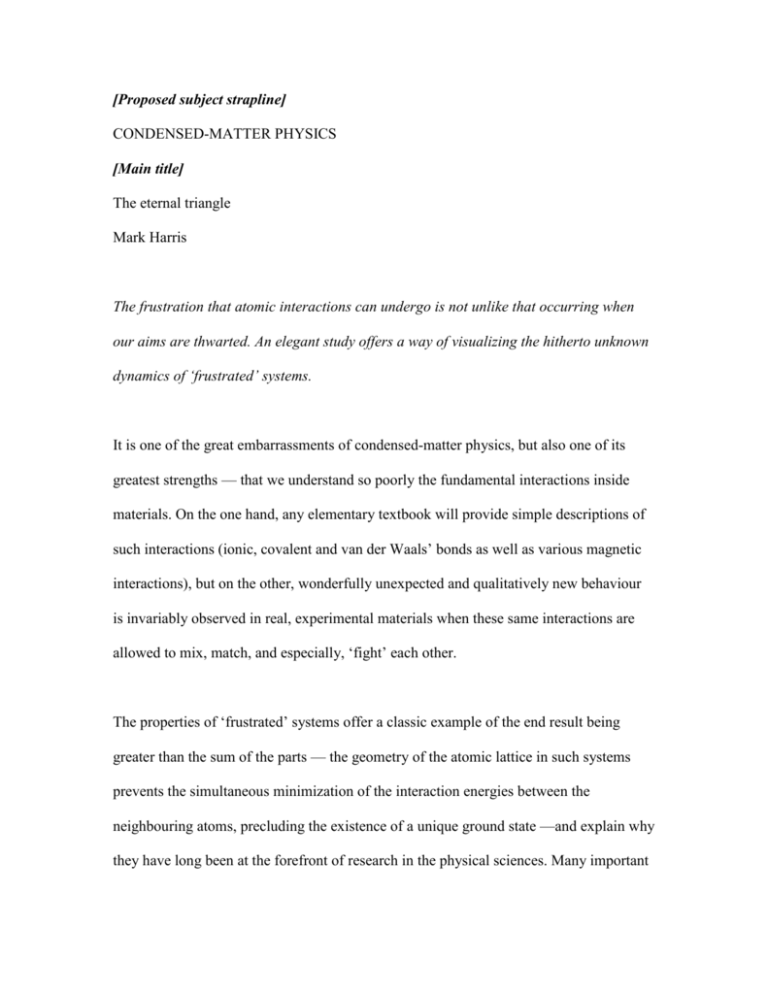
[Proposed subject strapline] CONDENSED-MATTER PHYSICS [Main title] The eternal triangle Mark Harris The frustration that atomic interactions can undergo is not unlike that occurring when our aims are thwarted. An elegant study offers a way of visualizing the hitherto unknown dynamics of ‘frustrated’ systems. It is one of the great embarrassments of condensed-matter physics, but also one of its greatest strengths — that we understand so poorly the fundamental interactions inside materials. On the one hand, any elementary textbook will provide simple descriptions of such interactions (ionic, covalent and van der Waals’ bonds as well as various magnetic interactions), but on the other, wonderfully unexpected and qualitatively new behaviour is invariably observed in real, experimental materials when these same interactions are allowed to mix, match, and especially, ‘fight’ each other. The properties of ‘frustrated’ systems offer a classic example of the end result being greater than the sum of the parts — the geometry of the atomic lattice in such systems prevents the simultaneous minimization of the interaction energies between the neighbouring atoms, precluding the existence of a unique ground state —and explain why they have long been at the forefront of research in the physical sciences. Many important commercial materials contain strongly-frustrated interactions which affect their physical properties (e.g. ferrite ceramic magnets). A better understanding of frustration might allow for more subtle ‘tuning’ of such materials, in order to achieve desired commercial properties. One of the long-standing problems in this area is that of the Ising anti-ferromagnet on the triangular lattice, the archetypal frustrated magnet which is stunningly simple to conceptualise but surprisingly elusive in nature, with a relative scarcity of experimental realisations. On page 000 of this issue, Han et al.1 describe experiments on a new kind of system, based on non-magnetic colloidal monolayers, that is shown to approximate the triangular Ising anti-ferromagnet in a number of ways. What’s more, its dynamics may be visualised directly in real time. Although Han and colleagues’ work involves an entirely non-magnetic soft-matter system, its significance is best appreciated by considering the way magnetic interactions behave on simple two-dimensional atomic lattices (Fig. 1). In the case of the triangular lattice, Gregory Wannier’s pioneering study2 predicted that the lowest-energy state of the system (its ground state) is disordered, and retains finite entropy even at absolute zero temperature. A closely related result was obtained by Philip Anderson in 1973 (ref. 3), when he considered the case of quantum spins on the triangular lattice and predicted that the ground state is a ‘spin-liquid’ state, containing strong dynamic correlations but no static order whatsoever, even down to the lowest temperatures. This tantalising spin- liquid state has preoccupied physicists ever since, especially because it was highlighted as a possible explanation for high-temperature superconductivity. Research has snowballed exponentially to consider many other types of geometrical frustration and spin-liquid behaviour, such as spin ice, pyrochlores, kagomé lattices, and kagomé ice, to name but a few examples4–8. Recent work has also pointed to the possibility of fabricating some of the classic frustrated models, for instance using nanoscale magnetic islands in thin-film form9. But so far, these techniques have not been exploited to probe the dynamics of the frustrated systems, and especially, how these systems explore their highly-degenerate ground states. One intriguing suggestion has been to test soft-matter colloidal systems in which the interactions between the particles can be tuned10, and the new results of Han et al. demonstrate their enormous potential. Their experiments were performed on a system of microgel colloidal spheres which selforganise into a buckled triangular lattice. The up- or down-displacements of the spheres are closely analogous to the up- or down-spin states of the Ising anti-ferromagnet. In terms of structure and interactions then, this new system presents a tantalising approximation to the triangular Ising antiferromagnet. Remarkably, the system is fully dynamic, which means that a number of poorly understood issues associated with frustrated systems can be investigated, particularly how individual particles reorganise themselves upon changes in the local environment, how defects arise and travel around the lattice, and how transitions to frozen, glassy states occur. Han and colleagues’ system comes with two further novelties. First, the interactions and dynamics of the system can be carefully fine-tuned (something which is difficult, if not impossible, with magnetic materials) through changes in the diameter of the microgel spheres. This clearly points towards the potential for investigating other statisticalmechanical models of disordered systems. Second, since the spheres are visible under a microscope, the microscopic dynamical properties can be observed in real time. With all this in mind, Han et al. notice interesting differences between the colloidal system and the ideal triangular Ising anti-ferromagnet. In particular, the colloid tends to relieve its frustration as the temperature is lowered by forming partially ordered ‘striped’ structures. This means that, instead of possessing a finite and extensive entropy — one that scales with the number of particles, N — at zero temperature, as would be the case in the triangular Ising antiferromagnet, the entropy is still finite but subextensive, and scales as N1/2. This subextensive entropy is reflected in the dynamics of the system. In particular, zero-energy modes are expected in the triangular Ising antiferromagnet, where certain local configurations can flip from one to the other with no energy cost even at zero temperature. But the colloid is devoid of such zero-energy modes, and the dynamics of the system is seen to slow down and become more ‘glassy’ than the Ising antiferromagnet as the temperature is lowered. These characteristics relate the colloidal system to many frustrated magnetic materials which also show glassy behaviour. Indeed, such glassiness at low temperature is a near-ubiquitous feature in experimental frustrated systems, and this is only poorly understood at present. But the fact that the microscopic dynamics of the colloid can be observed directly, and in real time, means that such microscopic effects can be probed more fully than ever before. For instance, Han et al.1 were able to see the nucleation, diffusion, and annihilation of defects directly, and their influence on the dynamics of neighbouring particles, knowledge of which has been very limited in frustrated systems so far. It is still early days for colloidal frustrated systems. There is much to try out, and Han et al. generously point the way by suggesting a variety of future experiments, including subjecting the colloidal system to probes as diverse as optical tweezers, gravitational and electric fields, or carefully controlled dopants. This diversity of ways in which the colloidal system can be manipulated highlights both its flexibility and its transparency as an experimental test bed of frustrated physics. With such fascinating possibilities for new research in view, one would hope that Han and colleagues’ proposals are adopted enthusiastically by frustrated magneticians the world over. Mark Harris is at Oriel College, University of Oxford, Oxford OX1 4EW, UK. e-mail: mark.harris@oriel.ox.ac.uk 1. Han, Y. et al. Nature 000, 000–000 (2008). 2. Wannier, G. H. Phys. Rev. 79, 357–364 (1950). 3. Anderson, P. W. Mat. Res. Bull. 8, 153–160 (1973). 4. Harris, M. J., Bramwell, S. T., McMorrow, D. F., Zeiske, T. & Godfrey, K. W. Phys. Rev. Lett. 79, 2554–2557 (1997). 5. Ramirez, A. P., Hayashi, A., Cava, R. J., Siddharthan, R. & Shastry, B. S. Nature 399, 333–335 (1999). 6. Castelnovo, C., Moessner, R. & Sondhi, S. L. Nature 451, 42–45 (2008). 7. Olariu, A. et al. Phys. Rev. Lett. 100, 087202 (2008). 8. Fennell, T., Bramwell, S. T., McMorrow, D. F., Manuel, P. & Wildes, A. R. Nature Phys. 3, 566–572 (2007). 9. Wang, R. F. et al. Nature 439, 303–306 (2006). 10. Libál, A., Reichhardt, C., Olson Reichhardt, C. J. Phys. Rev. Lett. 97, 228302 (2006). Figure 1 Geometric frustration. In many magnetic materials, the interactions between neighbouring atoms favour anti-parallel alignment of the magnetic moments (or spins), a property known as anti-ferromagnetism. a, When the atoms are arranged at the corners of a square lattice, the system can easily find an ordered structure which satisfies antiferromagnetism. b, When those same atoms are placed at the corners of a triangular lattice, only two out of the three spins can align anti-parallel, while the interactions of the third remain frustrated — the third spin can’t ‘decide’ with which of the other two neighbouring spins to align anti-parallel with. This is the basis of the Ising antiferromagnet on a triangular lattice, which is expected to be disordered at all temperatures. Han et al.1 describe a system of diameter-tunable microgel spheres that exhibits properties analogous to those of frustrated anti-ferromagnetic systems.

